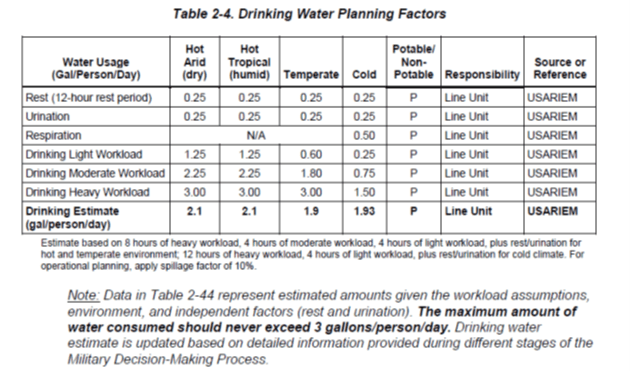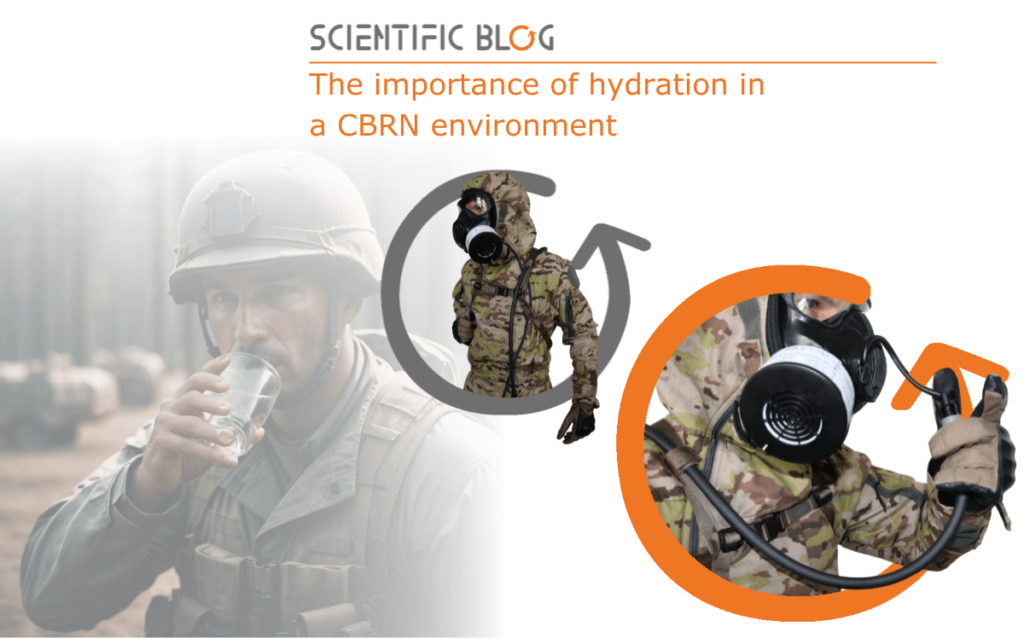The Importance of Hydration

Water is essential for life!
Just like air, water is a crucial element for life.
Water constitutes 60% of our body weight, about 40 liters for a 70 kg individual (with variations based on gender, age, and body fat). Our billions of cells contain two-thirds of our body’s water. Water also serves as the carrier for blood components and certain secretions (tears, digestive juices).
It is necessary for regulating body temperature (through sweating) and eliminating soluble wastes (urine). The body cannot survive without water for more than five days.
A loss of 10 to 15% of body water can lead to death. It’s clear how dependent our bodies are on water.
Water needs
Normal bodily functions result in the loss of approximately 3 liters of water per day due to:
- Breathing (0.5 L/day) (during intense exercise: 1-1.5 L/day)
- Sweating: 0.9 L/day (during exposure to heat and/or intense exercise: 1-2 L/hour)
- Urination (1.5 L/day)
- Bowel movements (0.1 L/day)
Increased sweating due to heat exposure or physical exertion leads to greater water loss. These losses should be balanced by equivalent intake of fluids and food.
Dehydration
Dehydration results from insufficient water intake or excessive loss of water and minerals. Sometimes, both factors contribute simultaneously, worsening the severity of the situation. This imbalance between “supply” and “demand” can result from:
- Inadequate intake: when a person does not drink or eat enough.
- Increased losses: high temperatures, prolonged exertion (excessive sweating), especially in direct sunlight, infectious episodes (fever, diarrhea, vomiting), significant burns…
- Effects of certain medications (especially diuretics) commonly used in treating heart failure.
- Excessive alcohol consumption.
Vulnerable age groups: children and the elderly
Dehydration risks apply to everyone, though no single factor protects individuals from this risk. However, “extreme” age groups require particular attention:
- Infants are especially sensitive to dehydration, which can quickly become fatal due to their inability to communicate and hydrate themselves independently, as well as the immaturity of their hydro-electrolytic regulation system.
- Older adults gradually lose their sense of thirst over the years and may be on medications that increase dehydration risk. They require careful monitoring during risky situations such as heatwaves.
Dehydration and body heat exchange quality
During exposure to heat and/or intense exercise, sweating increases significantly to maintain body temperature below 38°C. This leads to more pronounced dehydration in hotter conditions. Sweating can reach up to 2 L/hour, accompanied by a salt loss of 0.5 to 3 g/L.
Sweat evaporation from the skin surface is the most effective way to lose heat. Therefore, sweating effectively helps in heat loss if sweat can evaporate—this requires ensuring sweat doesn’t run off or get absorbed and ensuring the ambient air isn’t saturated with water vapor. Sprinkling water also aids in evaporation without losing water.
Sweat must evaporate to maintain our temperature. However, this natural thermostat only works under two conditions: adequate fluid intake to compensate for water losses and maintaining adequate salt concentration.
Consequences of Dehydration

If body water loss is less than 1%, no effects are observed; at 2%, thirst appears and physical capacity is impaired; at around 4%, intense thirst is felt, and physical and mental capacities are degraded (risk of reduced cognitive functions such as alertness, clarity); if it exceeds 5%, concentration difficulties, headaches, and physical exhaustion (cramps, etc.) occur; finally, if the deficit exceeds 6%, there is a risk of mental confusion. When dehydration reaches 15%, coma can ensue, leading to death.
Professions at risk of dehydration
Many professions expose workers to high temperatures (indoor work: laundries, kitchens, mines, blast furnaces… outdoor workers potentially exposed to high heat: construction, public works, agriculture…). During summer, the effects of high temperatures combined with machinery, products, or processes generating heat, wearing restrictive PPE hindering sweat evaporation, or engaging in intense physical activity increase dehydration risk.
What about military personnel?
The U.S. Army has estimated a soldier’s drinking water requirements at 3 to 4L per day, without exceeding approximately 12L per day (1.5L/h), depending on activity, environmental constraints and the wearing of PPE (see table below).
The U.S. Army Research Institute of Environmental Medicine (USARIEM) has developed a Soldier Water Estimation Tool (SWET) mobile application to help predict drinking water requirements based on 5 criteria: activity level (3 levels: easy, moderate, difficult), clothing, cloud cover, temperature, relative humidity.

And for military personnel in CBRN environments?
Health risks associated with dehydration in CBRN environments are described in PIA-3.8.2_MCO-NRBC (2008), based on field trials (CAPOPS).
CBRN protective equipment is impermeable to external agents, severely limiting sweat evaporation and thus normal thermoregulation (unless using air-permeable PPE filtering toxins).
Thermal stress results, exacerbated by humidity, solar radiation, workload, etc., quickly leading to harmful effects. Physical exertion generates heat that cannot be dissipated, increasing the risk of hyperthermia and heatstroke, even in moderate temperatures.
In hot environments, these effects are further intensified as heat accumulates and cannot be released, causing continuous elevation of body temperature and significant sweat losses (up to 2 liters per hour).
Additionally, wearing protective masks and limited water availability significantly hampers hydration efforts. Specific CBRN medications (pyridostigmine, atropine) also have aggravating side effects in hot environments.
Thus, combat conditions can lead to rapid human losses (less than an hour in certain conditions) due primarily to dehydration and excessive body temperature rise.
At the same time, wearing a protective mask and limiting the volume of water carried by the combatant considerably hampers his ability to rehydrate.In addition, protective equipment demands more active and energetic leadership. This increased activity causes considerable thermal overload, leading to premature exhaustion and “tactical” risks.
Last but not least, certain CBRN-specific drugs (pyridostigmine, atropine) have aggravating side-effects in hot environments.
As a result, real-life combat conditions can lead to very rapid loss of life (less than an hour under certain conditions), mainly due to dehydration and excessive body temperature rise.
For air temperatures of 35 to 40°C measured under shelter, the maximum duration of tolerance under level 4 CBRN personal protection, for any personnel carrying out physical work of even moderate to medium intensity, has been estimated at 2 hours.
The water requirements of military personnel wearing CBRN PPE are therefore very high, and hydration is therefore of paramount importance. What’s more, it’s advisable to drink every 15 minutes when exerting oneself, rather than a lot at once and less frequently, which reinforces the need to be able to hydrate in a CBRN environment.
Solutions to dehydration risk

Prevention
Actions should focus on organizing work (frequency of breaks, limiting physical work, task rotation…), and improving equipment. For military personnel, prevention involves pre-training and information, acclimatization to heat through physical preparation, and maintaining good lifestyle habits. Adequate and regular hydration (learning to drink) is crucial, with additional salt intake during meals or in rehydration beverages (2 sachets of 1 g salt in a 1.5-liter bottle).
Additionally, a balanced and varied diet, slightly increased in salt, helps compensate for energy and mineral losses.
Alcohol consumption should be avoided, respecting sleep hours is crucial, and personal hygiene should be optimized.
Adapting hydration for military personnel in CBRN environments
In level 4 heat PPE, hydration through the protective mask must be regular (every 15 minutes) and plentiful.For air temperatures of 30 to 40° C, the recommended quantities are :
En EPI de niveau 4 à la chaleur, l’hydratation au travers du masque de protection doit être régulière (toutes les 15 minutes) et abondante. Pour des températures d’air de 30 à 40° C, les quantités recommandées sont :
- 1.5 liters per hour for dynamic missions (lighting, reconnaissance, combat, etc.) ;
- 1 liter per hour for more static missions (observation, surveillance, etc.) ;
Note : physical recovery involves restoring the body’s hydromineral balance, which can be achieved by :
- Water intake, which depends on the level of dehydration observed at the end of the mission, and should represent one and a half times the weight loss (e.g. 3 liters for a loss of 2 kg). It should be distributed over a period of three hours, at rest, if possible in a cool place.
- Salt intake to compensate for what has been lost through profuse sweating. This should be at least 5 grams, and should be provided both in the drink and in the food.
How do I drink in a CBRN environment?
Hydration systems have been developed for use in CBRN environments: impermeable to exposure to CBRN agents, resistant, easy to wear, compatible with respiratory and face protection, and capable of continuing a mission without interruption, i.e. drinking with hands free and in a dynamic situation (on the move). NATO has drawn up standard AEP-4810 of June 2021 “On-the-move CBRN Proof Hydration System“, which gives recommendations for the development of such systems.
Take a close look at suppliers’ technical data to determine their compliance with this standard.
Field tests can be used to validate performance.



